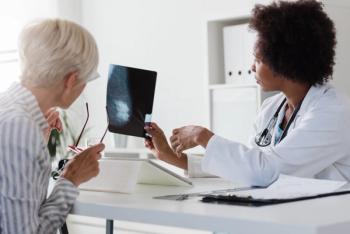
Update on Breast Cancer Treatments
Three Weeks of Two-Drug Chemotherapy as Good as Six Weeks of Triple Chemotherapy
A large study that compared two commonly used chemotherapy treatments for breast cancer showed that three months of therapy with adriamycin/cyclophosphamide (AC) was as effective as six months of treatment with cyclophosphamide/methotrexate/fluorourical (CMF) in women with early-stage, estrogen-receptor-negative breast cancer and no positive lymph nodes.
This is good news for women with early-stage breast cancer because they can now take a more convenient, shorter course of chemotherapy with the same assurance as with a longer course of therapy. Furthermore, the shorter two-drug course of chemotherapy has fewer side effects than the longer three-drug combination.
These results pertain to women with newly diagnosed breast cancer. If a woman who has early-stage, ER-negative, node-negative breast cancer is already taking CMF, "She should stay on that therapy and not switch," said Bernard Fisher, MD, National Surgical Adjuvant Breast and Bowel Project, University of Pittsburgh, PA.
After five years of follow-up with the 2,008 women enrolled in the trial, there was no difference in outcome between AC and CMF. Eighty-nine percent of women in both groups were alive at five years, and 82 percent were alive at five years with no recurrence.
These results suggest that AC can be safely substituted for CMF. "There has been a swing toward using AC, and these findings should accelerate the trend," said Dr. Fisher. Despite fear of cardiac toxicity with AC, the study showed no difference between the two combinations in that regard.A second goal of the study was to evaluate the use of tamoxifen in patients who have ER-negative tumors. The study showed that tamoxifen was of no value in this group of women; thus, tamoxifen should not be used in ER-negative breast cancer.
During a press conference on this study, five experts-including Dr. Fisher-agreed that in the year 2000, all women with breast cancer should be offered chemotherapy after surgery, but that not all women would benefit from it. Studies should be aimed at finding better markers to help select women with early-stage breast cancer who will derive benefit from chemotherapy.
Shorter Course of Radiation as Good as Longer Course After Lumpectomy
Standard treatment for early-stage, node-negative breast cancer is breast-conserving on surgery with lumpectomy, followed by a five-week course of radiation. A new study showed that three weeks of radiation following lumpectomy in these patients is as effective as five weeks, with a similar cosmetic outcome. If a shorter course of radiation is adopted, breast-conserving treatment will be more convenient and appealing for women. There will be fewer side effects from radiation-including fatigue-and treatment will be more cost-effective.
"This study suggests that women and their physicians can now opt for the shorter schedule with confidence," said Timothy Whelan, MD, Hamilton Regional Cancer Center, Ontario, Canada.
The study was conducted in Canada and included 1,234 women with early-stage, node-negative breast cancer randomized to receive either a three-week or five-week schedule of radiation following lumpectomy. Overall, five-year survival was 93.5 percent in the group that received the shorter course of radiation, and 94.3 percent in those treated for five weeks. Disease-free survival at five years was 88 percent in the first group and 90.4 percent in the second group. The incidence of recurrence of breast cancer was also similar: 16 in the short-course radiation therapy group and 17 in those treated for five weeks.
Radiation Plus Tamoxifen in Localized, Invasive Breast Cancer
A study suggests that radiation and tamoxifen are both needed to prevent the recurrence of breast cancer in the same breast in women with localized, node-negative, invasive breast cancer which measures one cm or less. The combination of radiation/tamoxifen was superior to using only one treatment in preventing recurrence of breast cancer in the same breast in the 1,009 women who entered this trial. However, tamoxifen alone was more successful than radiation alone in preventing cancer in the opposite breast.
"These results show that tamoxifen can't replace radiation for control of recurrence of cancer in the same breast. We thought that both treatments would reduce recurrence, but we were very surprised by the big difference that both treatments made for small tumors. Based on this study, we believe both therapies should become standard practice in women with localized, node-negative, invasive breast cancer of one cm or less," said Norman Wolmark, MD, Chairman of the National Surgical Adjuvant Bowel and Breast Project.
The study showed the risk of developing a new tumor in the same breast was 6.8 times higher for women who received tamoxifen alone and 3.9 times higher for women treated with radiation alone, compared with women who received both tamoxifen and radiation. The risk of developing a second tumor in a healthy breast or in either breast was also high in women who had only one of the therapies. Compared to women who had both tamoxifen and radiation, tamoxifen-only users had a 4.4 times greater risk of developing any breast tumor, and the risk was 2.3 times higher for women who received only radiation.
Hot Flashes Relieved by Low-Dose Antidepressant
There is good news for breast cancer survivors who suffer from hot flashes, either due to chemotherapy-induced menopause or natural menopause. These women should avoid hormone replacement therapy because of the risk of breast cancer, but now have another option. Low-dose venlafaxine, a commonly used antidepressant, has been found to relieve the frequency and severity of hot flashes in breast cancer survivors by as much as 61 percent. A two-thirds reduction in frequency and severity represents a sizeable benefit for women who cannot take hormone replacement therapy for their hot flashes.
"This is the most efficacious therapy we have for breast cancer survivors who have hot flashes," said Charles Loprinzi, MD, Mayo Clinic Cancer Center, Rochester, Minnesota.
The study included 180 breast cancer survivors with bothersome hot flashes. There were four treatment arms, including placebo, and three different doses of venlafaxine. The 75 mg per day dose of venlafaxine was found to be the most effective, which is about half the dose used to treat depression. Dr. Loprinzi emphasized the low-dose antidepressant does not completely abolish the hot flashes, but it does provide substantial relief with few side effects.
Other studies suggest newer antidepressants, such as Paxil® and Prozac®, may share the ability to relieve hot flashes. Additionally, preliminary studies suggest that men who have hot flashes induced by hormone therapy for prostate cancer can gain relief from low-dose antidepressant therapy. Also, women who desire relief from hot flashes but do not want to take hormones, may possibly achieve this effect with an antidepressant. Studies are needed to prove that low-dose antidepressant therapy works for men with hot flashes and for menopausal women who have not had breast cancer.
References:
This Report is a product of Millennium Medical Communications, Inc. ("MMC, Inc."), an independent, third-party organization providing educational information concerning current medical data and opinions presented at worldwide medical meetings. This Report is published in accordance with the Guidance for Industry: Industry Supported Scientific and Educational Activities, 62 Fed. Reg. 64,093, 64,096-99 (1997) adopted by the U.S. Department of Health and Human Services Food and Drug Administration. Pursuant to the foregoing standards, MMC, Inc. is solely responsible for selecting the topics discussed herein as well as the guest editor. The ideas and opinions expressed by the guest editor are those solely of the guest editor and do not necessarily reflect the opinions of Millennium Medical Communications, Inc. or any Sponsor hereto. This Report may contain data on products, product uses, indications, and dosages, which are not approved for use in the USA, Canada and the European Union and no endorsement is hereby made or intended by coverage of any unapproved use. The content of this report is intended for educational purposes only, and merely conveys scientific data presented at medical meetings. Approved product labeling should always be consulted for prescribing information. This Report is an independent and non-promotional report intended to provide accurate scientific and medical information for educational purposes. MMC, Inc. is not responsible for errors or omissions in reports. The production of this report was paid for by MMC, Inc.
© 2000 Millennium Medical Communications, Inc.
Contact Information:
Millennium Medical Communications
Bridget R. Dupuis, RN, BSN
Director of Business Development
(603) 929-5078 x 109
Newsletter
Get the latest clinical updates, case studies, and expert commentary in obstetric and gynecologic care. Sign up now to stay informed.




